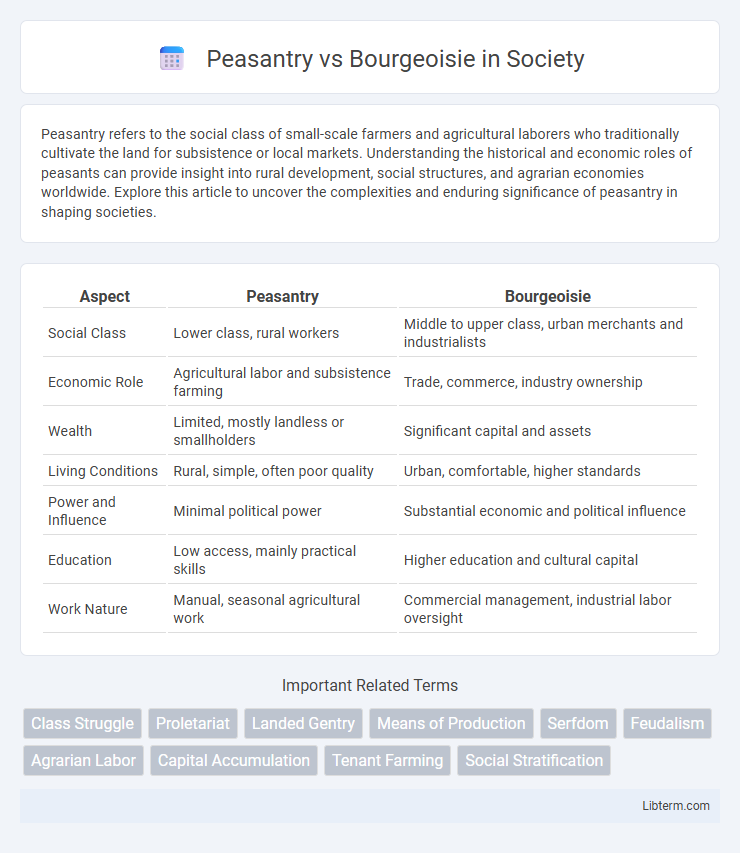Peasantry refers to the social class of small-scale farmers and agricultural laborers who traditionally cultivate the land for subsistence or local markets. Understanding the historical and economic roles of peasants can provide insight into rural development, social structures, and agrarian economies worldwide. Explore this article to uncover the complexities and enduring significance of peasantry in shaping societies.
Table of Comparison
| Aspect | Peasantry | Bourgeoisie |
|---|---|---|
| Social Class | Lower class, rural workers | Middle to upper class, urban merchants and industrialists |
| Economic Role | Agricultural labor and subsistence farming | Trade, commerce, industry ownership |
| Wealth | Limited, mostly landless or smallholders | Significant capital and assets |
| Living Conditions | Rural, simple, often poor quality | Urban, comfortable, higher standards |
| Power and Influence | Minimal political power | Substantial economic and political influence |
| Education | Low access, mainly practical skills | Higher education and cultural capital |
| Work Nature | Manual, seasonal agricultural work | Commercial management, industrial labor oversight |
Understanding the Peasantry and Bourgeoisie
The peasantry consists primarily of rural agricultural workers who often own or cultivate small plots of land, embodying traditional, subsistence-based economies. The bourgeoisie represents the urban middle and upper classes, owning capital and means of production, driving commerce, industry, and capitalist economies. Understanding these classes is crucial for analyzing socio-economic structures, historical conflicts, and shifts in power dynamics within societies.
Historical Origins of Class Distinctions
The historical origins of class distinctions between peasantry and bourgeoisie trace back to the feudal era, where peasants were primarily agricultural laborers bound to land owned by nobility, while the bourgeoisie emerged later as urban merchants and artisans gaining economic power through trade and industry. The dissolution of feudal structures during the late Middle Ages and Renaissance allowed the bourgeoisie to accumulate wealth independently of land ownership, establishing a distinct class with financial capital and social influence. This economic shift laid the groundwork for modern class dynamics, contrasting rural subsistence with urban capitalist enterprise.
Social and Economic Roles
The peasantry primarily engaged in agricultural labor, sustaining local economies through subsistence farming and limited market participation, while the bourgeoisie controlled production means and capital, driving urban economic growth and industrial expansion. Socially, peasants often formed the rural lower class with limited political power, contrasted by the bourgeoisie's rising influence in commerce, politics, and cultural institutions during economic modernization. This division underscores historical class dynamics where economic roles reinforced social stratification between land-dependent peasants and capital-owning bourgeoisie.
Power Dynamics and Class Conflict
The power dynamics between peasantry and bourgeoisie revolve around economic control and social hierarchy, where the bourgeoisie exploit land ownership and capital to dominate agricultural production and labor conditions. Class conflict intensifies as peasants resist exploitation through collective action, seeking land reform and fair wages to challenge the bourgeoisie's monopolization of wealth and political influence. This struggle reflects broader systemic inequalities that reinforce societal divisions and perpetuate cycles of poverty and disenfranchisement among rural populations.
Land Ownership and Labor Systems
Peasantry primarily relied on subsistence farming and often worked as tenant farmers or sharecroppers on lands owned by the bourgeoisie, who controlled substantial parcels of property through capital accumulation. The bourgeoisie implemented wage labor systems and enforced legal property rights that restricted peasant access to land, fundamentally shaping economic and social hierarchies. This dynamic created class distinctions where land ownership determined political power, economic opportunity, and labor exploitation patterns.
Urbanization and the Rise of the Bourgeoisie
The rise of the bourgeoisie was intrinsically linked to rapid urbanization during the late medieval and early modern periods, as cities expanded and became centers of trade, finance, and industry. Unlike the peasantry, who were tied to rural agrarian lifestyles and feudal obligations, the bourgeoisie capitalized on commerce, manufacturing, and professional services, accumulating capital and influencing political power structures. This economic shift contributed to the decline of feudalism and the restructuring of societal hierarchies, with urban centers serving as the focal point for bourgeois wealth and social mobility.
Impact of Industrialization on Class Relations
Industrialization transformed class relations by accelerating the decline of peasantry as mechanized agriculture reduced the demand for rural labor, forcing many peasants to migrate to urban areas for factory work. The bourgeoisie expanded their economic and political influence as industrial capitalists, controlling production and shaping modern capitalist economies. This shift deepened class stratification, intensifying conflicts between industrial workers and capitalist owners over wages, working conditions, and social mobility.
Cultural Values and Worldviews
Peasantry embraces communal traditions, valuing subsistence, close ties to land, and collective rituals that reinforce social cohesion. Bourgeoisie prioritizes individualism, economic progress, and innovation, emphasizing personal success and material accumulation as cultural markers. These contrasting worldviews shape social interactions, with peasants often resisting rapid change while bourgeois values drive transformation and modernization.
Political Revolutions and Class Struggle
The peasantry, often burdened by feudal obligations and economic hardships, frequently fueled political revolutions by challenging the bourgeoisie, who controlled urban wealth and political power. Class struggle between these groups intensified during periods of upheaval, as peasants sought land reforms and social justice while the bourgeoisie aimed to expand capitalist economic structures and bourgeois democracy. This conflict shaped the dynamics of revolutions, exemplified in events such as the French Revolution, where the alliance and tension between these classes redefined power distribution and social hierarchies.
Legacy and Relevance in Modern Society
The legacy of peasantry and bourgeoisie continues to shape contemporary socio-economic structures, where peasantry represents traditional agrarian economies and the bourgeoisie symbolizes capitalist class power rooted in industrialization and commerce. Modern society exhibits persistent class distinctions and economic disparities reflecting these historical roles, influencing land ownership, labor rights, and wealth distribution debates. Understanding this dynamic clarifies current discussions on social justice, economic inequality, and cultural identity in global contexts.
Peasantry Infographic

 libterm.com
libterm.com